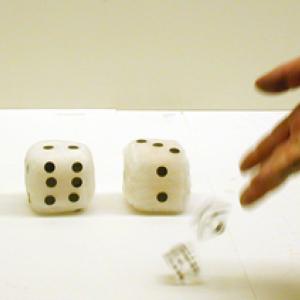College of Liberal Arts & Sciences
1A20.25 - Statistics and Probability - Dice
Roll the dice and add the numbers together and then record. A Gaussian distribution should be observed after multiple runs, with the number 6 having the most hits and the numbers 2 and 12 having the least.
- W. Brian Lane, "Using Dice Towers in an Introductory Physics Lab", TPT, Vol. 57, #1, Jan. 2019, p. 28.
- Michael C. LoPresto, "A Simple Statistical Thermodynamics Experiment", TPT, Vol. 48, #3, Mar. 2010, p. 183.
- Sergio Fantini and Jeffrey C. Grossman, "How Likely Is It Two Classmates Have the Same Birthday?", TPT, Vol. 35, #1, Jan. 1997, p. 42.
- Patricia F. Bronson and Robert L. Bronson, "Dice with Parallelepiped Shapes", TPT, Vol. 28, #5, May 1990, p. 286.
- John Burke and Eric Kincanon, "Benford's Law and Physical Constants: The Distribution of Initial Digits", AJP, Vol. 59, #10, Oct. 1991, p. 952.
- Don S. Lemons, "On the Numbers of Things and the Distribution of First Digits", AJP, Vol. 54, #9, Sept. 1986, p. 816.
- Eugene M. Levin, "Experiments with Loaded Dice", AJP, Vol. 51, #2, Feb. 1983, p. 149.
- Joseph Ford, "How Random is a Coin Toss?", Physics Today, Vol. 36, #4, Apr. 1983, p. 40.
- M-010: "Distribution of First Digits", DICK and RAE Physics Demo Notebook.
- Martin Gardner, "Surprising Dice Bet", Science Tricks, p. 86.
- Martin Gardner, "Magic with Dice", Entertaining Science Experiments with Everyday Objects, p. 62.
- Martin Gardner, "Probability", Entertaining Science Experiments with Everyday Objects, p. 51.
- Yaakov Kraftmakher, "1.16, Probability Functions", Experiments and Demonstrations in Physics, p. 62.
- Robert Ehrlich, "Spinning a Penny", Why Toast Lands Jelly-Side Down, p. 72 - 73.
- Courtney Linder, "When Dice-Roll Games Aren't Totally Random", Popular Mechanics, March/April 2022, p. 26.
- John F. Ross, "Discovering the Odds", How it Works - Science Supplement, Spring 2001, p. 181.
- Neil. A. Downie, "Motor Dice", Ink Sandwiches, Electric Worms and 37 Other Experiments for Saturday Science, p. 176.
- Susan H. McClung, "Mathematics", How it Works - Science Supplement, Spring 2001, p. 296.
- Portable Press, "Roll the Dice" and "Dicey History", Strange History, p. 281 & 282.
Disclaimer: These demonstrations are provided only for illustrative use by persons affiliated with The University of Iowa and only under the direction of a trained instructor or physicist. The University of Iowa is not responsible for demonstrations performed by those using their own equipment or who choose to use this reference material for their own purpose. The demonstrations included here are within the public domain and can be found in materials contained in libraries, bookstores, and through electronic sources. Performing all or any portion of any of these demonstrations, with or without revisions not depicted here entails inherent risks. These risks include, without limitation, bodily injury (and possibly death), including risks to health that may be temporary or permanent and that may exacerbate a pre-existing medical condition; and property loss or damage. Anyone performing any part of these demonstrations, even with revisions, knowingly and voluntarily assumes all risks associated with them.
